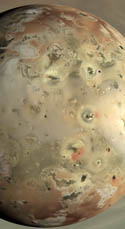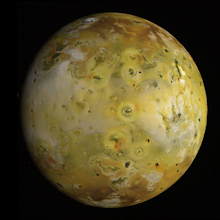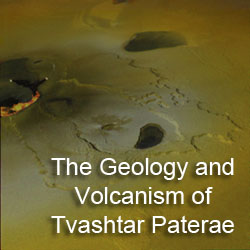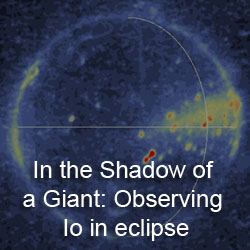 Okay, it has been a while since I have discussed the Io Volcano Observer (IVO). This mission concept was developed in response to the Discovery and Scout Mission Capability Extension (DSMCE, pronounced DOS-MICE). The DSMCE program was started by NASA to examine the viability of Discovery-class mission powered by next-generation radioisotope power generators provided to the PIs at no cost to the mission. The IVO study is headed by Alfred McEwen at the University of Arizona with scientists and engineers at Ball Aerospace, USGS-Flagstaff, JPL, and the University of Bern in Switzerland.
Okay, it has been a while since I have discussed the Io Volcano Observer (IVO). This mission concept was developed in response to the Discovery and Scout Mission Capability Extension (DSMCE, pronounced DOS-MICE). The DSMCE program was started by NASA to examine the viability of Discovery-class mission powered by next-generation radioisotope power generators provided to the PIs at no cost to the mission. The IVO study is headed by Alfred McEwen at the University of Arizona with scientists and engineers at Ball Aerospace, USGS-Flagstaff, JPL, and the University of Bern in Switzerland.Check out my previous posts on IVO, particularly those from LPLC after a talk by Dr. McEwen, and one based on the conference abstract.
Well, obviously, despite the fact that the initial study is finished, very little has shown up on the web. There is a good reason for that. There is a very good chance that McEwen et al. will submit a proposal for the mission with the Discovery Announcement of Opportunity is released next year (April 2009?). Despite this, I have found a new online source for information on the mission, particularly on the Ion and Neutral Gas Mass Spectrometer (INMS) from a presentation given by the Peter Wurz of the University of Bern in October.
The presentation's fifth slide provides an overview of the IVO mission, mostly with details that were previously known. Three instruments are planned for IVO's payload: a narrow-angle camera, a thermal infrared imager, and an ion and neutral mass spectrometer. A Radiation Detector and Ultraviolet Spectometer are not mentioned, like in Dr. McEwen's presentation in May. The baseline mission plan remains much the same as was outlined by Dr. McEwen: a launch planned for 2013 (with a backup in 2014), Jupiter orbit insertion in 2020 with the first Io flyby in June 2020 (a year later than the baseline mission presented in May), and a science phase that runs 16 months to October 2021. Considering that the initial Jovian orbit following the first Io flyby is expected to run on the order of 200 days, the other nine flybys are planned between December 2020 and October 2021 occurring on the order of about once a month.
 Dr. McEwen's presentation at LPSC went into a bit of detail of the Narrow-angle camera and the thermal imager, but he ran out of time before he could get to the INMS. Therefore, the presentation by Wurz is complementary to McEwen's. IVO's INMS is a time-of-flight mass spectrometer with some design heritage with the ROSINA instrument on Rosetta. P-BACE, a spectrometer similar to the one planned for IVO, was developed at Bern and was aboard MEAP, a stratospheric balloon mission that recorded measurements of the circumpolar wind patterns between Sweden and Canada. Based on the measurements acquired by P-BACE, Wurz and Thomas expect to be able to measure most of the atmospheric species expected at Io, such as sulfur dioxide, sulfur, hydrogen sulfide, sodium, potassium, and oxygen.
Dr. McEwen's presentation at LPSC went into a bit of detail of the Narrow-angle camera and the thermal imager, but he ran out of time before he could get to the INMS. Therefore, the presentation by Wurz is complementary to McEwen's. IVO's INMS is a time-of-flight mass spectrometer with some design heritage with the ROSINA instrument on Rosetta. P-BACE, a spectrometer similar to the one planned for IVO, was developed at Bern and was aboard MEAP, a stratospheric balloon mission that recorded measurements of the circumpolar wind patterns between Sweden and Canada. Based on the measurements acquired by P-BACE, Wurz and Thomas expect to be able to measure most of the atmospheric species expected at Io, such as sulfur dioxide, sulfur, hydrogen sulfide, sodium, potassium, and oxygen.The scientific goals for IVO's mass spectrometer include: measurements of Io's atmospheric scale height and major components; a search for differences in these measurements as a result of temporal changes, geography, or day-night cycles; measurement of atmospheric loss mechanisms and rates (due to sputtering for example); and measurements from within a volcanic plume.
Overall, the INMS looks like an interesting addition to the mission. The instrument could also take on increased importance as a similar instrument may not make it on the Europa Orbiter since the instrument would push the cost of the EO above that project's budgetary "sweet spot." So even if Europa Orbiter is selected as the next Outer Planets flagship mission, IVO might still get proposed because of unique measurments a mass spectrometer could make. IVO could also provide a useful stopgap between New Horizons and EO (planned to arrive in the late 2020s).
(Before you ask, the graphic at the top is an old, 1990s-era graphic of IVO, so just ignore the solar panels ;)










No comments:
Post a Comment